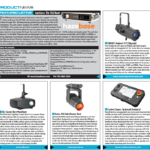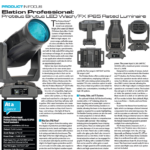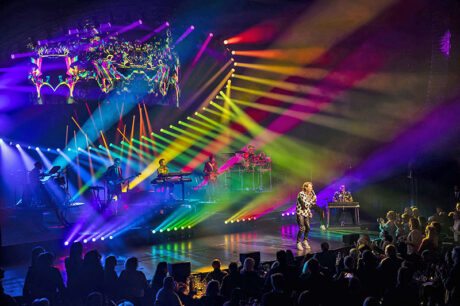
Featuring three of Sweden’s biggest singing stars—Anders Glenmark, Orup (Thomas Eriksson) and Niklas Strömstedt—the Swedish pop supergroup GES, wrapped up their 2022 tour with a 33-date sold-out residency at Stockholm’s famous Cirkus venue. Having kicked off their tour in 2021 at Cirkus, it all came full circle, a theme reflected within the show’s production design as well.
Designer Palle Palmé based his lighting and visual stage design around the architecture of the venue’s unique circular-shape. The design featured two truss circles—large and small—and a curved LED screen, all on an automation system, as well as an all-Robe lighting rig in the air. Palmé chose Robe products as he felt they gave him all the versatility to create the energy needed to match the enormous energy and enthusiasm of the band. The fast-paced show played through a string of hits from the collective and individual careers of GES and the energy pumped relentlessly from the first bars to the last strains of the final number. Palmé’s major task was keeping everything looking fresh and vital for two hours.
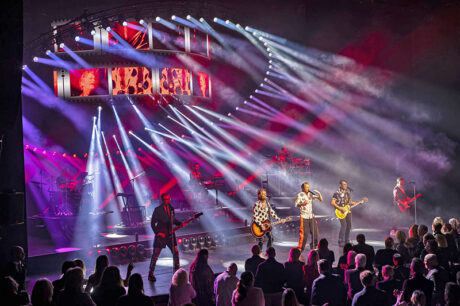
Lighting Around
The overhead rig comprised 64 Robe LEDBeam 150s, 16 MegaPointes, 17 BMFL WashBeams, and three RoboSpot systems running six more of the BMFL WashBeams. The RoboSpot system had also been an important element of the touring lighting system. All of the Robe fixtures, supplied to the Cirkus dates by rental company Musiklagret from Borås, were chosen for their versatility and power, which was essential to allowing Palmé to create a wide range of dynamics and fluidity. Eleven of the BMFL WashBeams are on the front truss, used for keys and specials, with another six upstage on the floor, shooting through from the back. The 64 LEDBeam 150s were equidistantly spaced out around the larger, almost 33’ diameter, circle truss. Palmé selected the LEDBeam 150s for their small size, speed, and uniqueness as a compact LED wash luminaire. He loves the “fabulous” zoom which adds a different dimension and finds them effortless to handle.
He then had 16 MegaPointes rigged in the smaller, almost 10’ diameter, truss that worked in conjunction with the LEDBeam 150s. Palmé maximized the MegaPointes gobos, prisms and other features that make this fixture a good go-to light for effects. Palmé remarked on how well the two fixture types—LEDBeam 150 and MegaPointe—blend and contrast in this case and noted the great match in colors. The interaction between the two fixture types becomes more pronounced during the closing numbers of the set list, where the circles are flown into multiple dramatic positions, pitching, and flying in and out within one another.
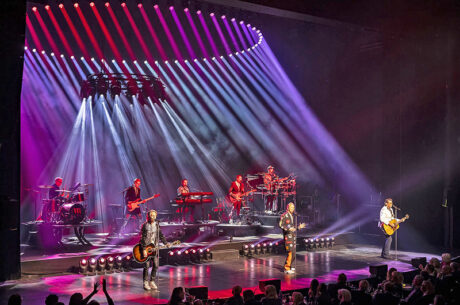
Moving Circles
Right at the heart of Palmé’s design was the dynamics of movement so automation was integral to the show and he used judiciously to bring a fresh edge to the overall stage look throughout the set. He explains, “Automation was an essential element of this show’s aesthetic. It was an ideally suited performance environment for the extra visual thrill of automation.” Along with the two circular lighting trusses that each moved individually, Palmé’s design included a 16’ diameter semi-circular LED screen which flew in and out at strategic moments. The two truss circles interacted fluidly throughout the performance, controlled by automation operator Emanuel Hochholzer using Kinesys Vector control. The Kinesys system, which also featured Elevation drives working with eleven 500kg EXE hoists, was specified and supplied by Sören Durango at Sundsvall based Scandinavian Rigging Service.
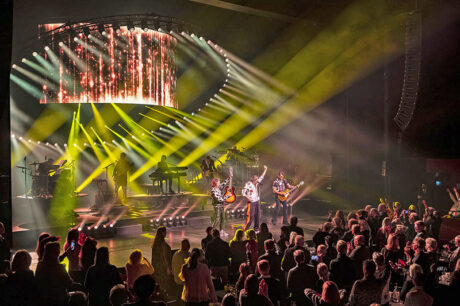
Palmé wanted to use the three-dimensionality of automation to change the shape and architecture of the stage space, with over 40 cues in the Vector console. This started subtly, building up to more extreme and intense moves towards the end of the set with the circles pitching dramatically. “It was important to make everything fun in this show, so having the ability to move the whole rig offered so much more scope for engaging the audience and keeping them guessing as to what might happen next,” commented Palmé, adding that all of the songs offered “fantastic” material to light and to animate.
The LED screen was used judiciously for around a third of the songs in the set, so when not in use, it flew out of the way leaving a clean and uncluttered stage look. Both of the circle trusses were rigged using four 500kg EXE hoists running with Kinesys Elevation drives with another three deployed for lifting and lowering the LED screen truss. Hochholzer, a freelance lighting and automation technician and programmer, finds Kinesys easy to program and intuitive to use, especially for those with a lighting background. Learning to set the system up is also “relatively straightforward” and he enjoys programming quickly once this is complete. “Above all, the kit is reliable,” he observes and adds, “I enjoy working with it.”
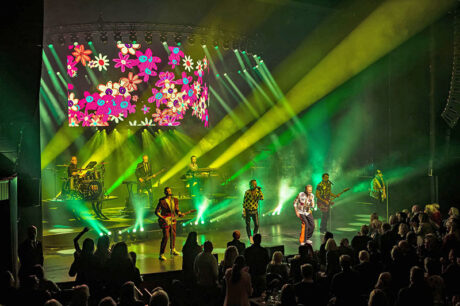
Spot Focus
For followspots Palmé went with six RoboSpot controlled BMFL WashBeams, which were all on the front truss, with two lights dedicated to each member of GES. “I’ve tried a lot of different remote systems in recent years, and this is one of the best and the most straightforward to set up and use,” Palmé stated. For one song, “Rain with Me”, a fixed breakup gobo together with the animation wheel in the BMFL WashBeam is used on Orup, creating a rain-effect that would have been impossible using a standard followspot. Palmé thinks that having access to these possibilities adds real value to the RoboSpot package. While he loves traditional followspots and respects the associated art of operating them, he feels that RoboSpot, with its human element, combines new tech with traditional skills very well, adding that his followspot operators have been fundamental to this show. “It’s always been a really vital role,” he confirmed, “which continues whether it’s a manual or technology assisted operation.” All the BMFL WashBeam parameters were run through the grandMA2 console, so all the RoboSpot operators had to do in this case was concentrate on following their targets. The show’s lighting console operator was Edvin Nyström.
Palmé enjoyed working on the GES show, concluding, “There was much scope for interdisciplinary and crossover techniques.” His use of that versatility and combination of lighting and automation certainly resulted in creating an engaging visual design. The pop aesthetic merged moments of theatre with arena show along with classic pop, rock, and EDM lighting as the band played through a masterwork of GES’s individual and collective hits, much to the delight of their diverse fanbase.

This coverage was shared with PLSN by Robe and Kinesys.

